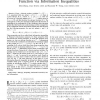Free Online Productivity Tools
i2Speak
i2Symbol
i2OCR
iTex2Img
iWeb2Print
iWeb2Shot
i2Type
iPdf2Split
iPdf2Merge
i2Bopomofo
i2Arabic
i2Style
i2Image
i2PDF
iLatex2Rtf
Sci2ools
TIT
1998
1998
On Characterization of Entropy Function via Information Inequalities
—Given n discrete random variables = fX1;111; Xng, associated with any subset
of f1; 2; 111; ng, there is a joint entropy H(X
) where X
= fXi:i 2
g. This can be viewed as a function defined on 2f1;2;111;ng taking values in [0; +1). We call this function the entropy function of . The nonnegativity of the joint entropies implies that this function is nonnegative; the nonnegativity of the conditional joint entropies implies that this function is nondecreasing; and the nonnegativity of the conditional mutual informations implies that this function has the following property: for any two subsets
and
of f1; 2; 111;ng H (
) + H (
) H (
[
) + H (
\
): These properties are the so-called basic information inequalities of Shannon’s information measures. Do these properties fully characterize the entropy function? To make this question more precise, we view an entropy function as a 2n 0 1-dimensional vector where the coordinates are indexed by the nonempty subsets of the ground ...
Related Content
| Added | 23 Dec 2010 |
| Updated | 23 Dec 2010 |
| Type | Journal |
| Year | 1998 |
| Where | TIT |
| Authors | Zhen Zhang, Raymond W. Yeung |
Comments (0)

